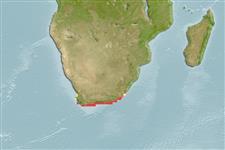Actinopterygii (ray-finned fishes) >
Perciformes (Perch-likes) >
Pseudochromidae (Dottybacks) > Congrogadinae
Etymology: Halidesmus: Greek, als, alis = salt + Greek, desmos = link, bond (Ref. 45335). More on author: Günther.
Environment / Climate / Range
Ecology
Marine; demersal; depth range 0 - 16 m. Subtropical, preferred ?; 31°S - 35°S
Southeast Atlantic: False Bay, Cape Province to Coffee Bay, Transkei in southeastern Africa.
Size / Weight / Age
Maturity: Lm ? range ? - ? cm
Max length : 20.0 cm TL male/unsexed; (Ref. 4395)
Dorsal
spines
(total): 1;
Dorsal
soft rays
(total): 58-63;
Anal
spines: 0;
Anal
soft rays: 48 - 52;
Vertebrae: 66 - 69. Light to dark brown with color, sometimes with dusky crossbars (Ref. 4395). Middle lateral line joining with the dorsal lateral line just above the pectoral fin base; midline of parietal canal with a single pore; dark spot above pectoral fin (Ref. 531). Pelvic fin rarely absent; dorsal and anal fin membranes united only basally to caudal fin (Ref. 49841).
Common in intertidal pools and marginal subtidal areas (Ref. 4395).
Life cycle and mating behavior
Maturity | Reproduction | Spawning | Eggs | Fecundity | Larvae
Winterbottom, R., 1985. Revision and vicariance biogeography of the subfamily Congrogadidae (Pisces: Perciformes: Pseudochromidae). Indo-Pac. Fish. (9):34 p. (Ref. 531)
IUCN Red List Status (Ref. 115185)
CITES (Ref. 94142)
Not Evaluated
Threat to humans
Harmless
Human uses
More information
Common namesSynonymsMetabolismPredatorsEcotoxicologyReproductionMaturitySpawningFecundityEggsEgg development
ReferencesAquacultureAquaculture profileStrainsGeneticsAllele frequenciesHeritabilityDiseasesProcessingMass conversion
Tools
Special reports
Download XML
Internet sources
